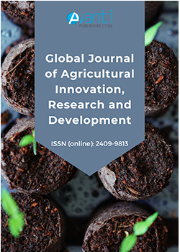Abstract
Anaerobic soil disinfestation (ASD) has been optimized and adopted as an organic alternative to chemical fumigation by strawberry growers in California. The ASD process relies on mixing labile carbon sources into the soil to generate chemical, physical, and microbiological changes aiding suppression of the soil-borne pathogens and enhancing fruit production. Continued ASD adoption is hindered by the increasing cost of rice bran, currently the most widely used carbon source. To address this need and to find suitable and economical alternative carbon sources, we conducted field evaluations of locally produced or sourced plant-based products. ASD with incorporated grass-sod clippings spent grain and coffee grounds from one supplier provided a 47% to 83% increase in fruit yields compared to untreated soil, but coffee grounds from a different supplier decreased strawberry yields. Carbon, nitrogen, and their ratios had important impacts on the efficacy of ASD with coffee grounds and grape pomace. ASD with wheat midds at 20 t/ha provided strawberry yields similar to chloropicrin-fumigated soil while substituting 30% of rice bran carbon rate with on-site grown cereal cover crop biomass resulted in yields similar to the full rate of rice bran but at a reduced cost. As we continue exploring cost-effective methods of soil disinfestation, we utilize ASD integrated with other pest management tools, such as the use of resistant cultivars and crop rotation for sustainable production.
References
National Berry Report. 2019. USDA Agricultural Marketing Service; USDA Fruit and Vegetable Market News On line at: https://www.marketnews.usda.gov/mnp/fv-home.
Daugovish O. Current status and distribution of pest problems in southern California and pros's and con's of disinfestation practices. Proceedings of MBAO Intl. Conference. 2017; 5: 1-2. San Diego, CA.
Samtani J, Rom C, Friedrich H, Fennimore S, Finn C, Petran A, et al. The status and future of the strawberry industry in the United States HortTechnol. 2019; 29(1):11-24.https://doi.org/10.21273/HORTTECH04135-18
Daugovish O, Knapp S, Gordon T, Fennimore S, Muramoto J, Bolda M. Soil pest management in current California strawberry production: a review. Acta Hortic. 2021; 1309: 701-709.https://doi.org/10.17660/ActaHortic.2021.1309.101
Blok WJ, Lamers JG, Termorshuizen AJ, Bollen GJ. Control of soil-borne plant pathogens by incorporating fresh organic amendments followed by tarping. Phytopathology 2000; 90: 253-259.https://doi.org/10.1094/PHYTO.2000.90.3.253
Shinmura A. Principle and effect of soil sterilization methods by reducing the redox potential of soil. PSJ Soilborne Disease Workshop Report 2004; 22: 2-12 (in Japanese with English Summary).
Fennimore S, Serohijos R, Samtani J, Ajwa H, Subbarao K, Martin F, et al. TIF film, substrates and non-fumigant disinfestation maintain yields. California Agriculture 2013; 67(3): 139-146. https://doi.org/10.3733/ca.v067n03p139
Shennan C, Muramoto J, Koike S, Baird G, Fennimore S, Samtani J, et al. Anaerobic soil disinfestation is a potential alternative to soil fumigation for control of some soil borne pathogens in strawberry production. Plant Pathology 2018; 67(1): 51-66. https://doi.org/10.1111/ppa.12721
Muramoto J, Shennan C, Mazzola M, Wood T, Miethke E, Resultay E, et al. Use of a summer cover crop as a partial carbon source for anaerobic soil disinfestation in coastal California. Acta Hort. 2020; 1270: 37-44. https://doi.org/10.17660/ActaHortic.2020.1270.4
Muramoto J, Shennan C, Zavatta M, Baird G, Toyama L, Mazola M. Effect of anaerobic soil disinfestation and mustard seed meal for control of charcoal rot in California strawberries. Intl. J. Fruit Sci. 2016; 16: 59-70. https://doi.org/10.1080/15538362.2016.1199993
Daugovish O, Shennan C, Muramoto J, Mazzola M. Carbon source and irrigation affect anaerobic soil disinfestation in strawberry. Proceedings of MBAO Intl. Conference 2015; 12: 1-3. San Diego, CA.
University of California, Davis. 2021. SoilWeb. 14 Apr. 2021; < https://casoilresource.lawr.ucdavis.edu/soilweb-apps/ >.
Butler DM, Kokalis-Burelle N, Muramoto J, Shennan C, McCollum TG, Rosskopf EN. Impact of anaerobic soil disinfestation combined with soil solarization on plant parasitic nematodes and introduced inoculum of soil-borne plant pathogens in raised-bed vegetable production. Crop Protection 2012; 39: 33-40. https://doi.org/10.1016/j.cropro.2012.03.019
Strand L. Integrated pest management for strawberries. University of California Statewide Integrated Pest Management Project. Agriculture and Natural Resource Publication 1994; 3351.

This work is licensed under a Creative Commons Attribution-NonCommercial 4.0 International License.




